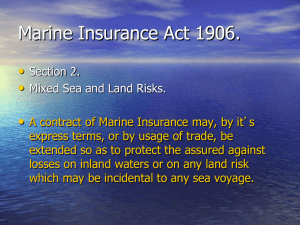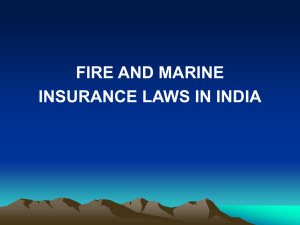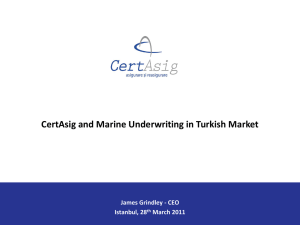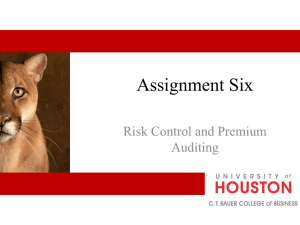MARINE_INSURANCE
advertisement
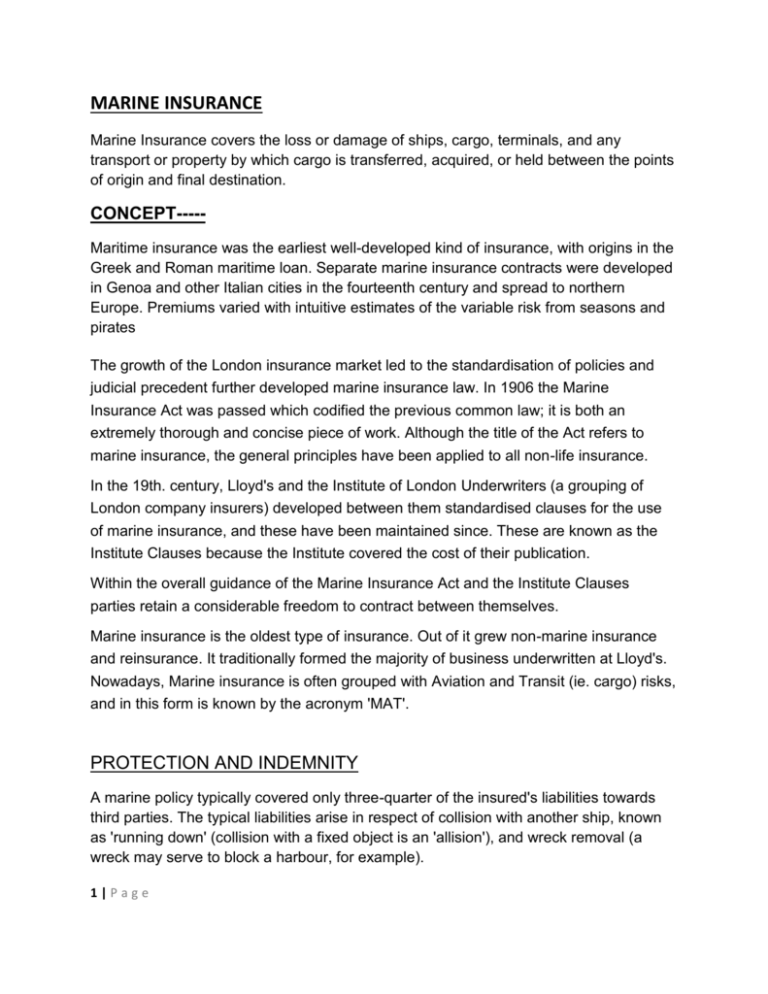
MARINE INSURANCE Marine Insurance covers the loss or damage of ships, cargo, terminals, and any transport or property by which cargo is transferred, acquired, or held between the points of origin and final destination. CONCEPT----Maritime insurance was the earliest well-developed kind of insurance, with origins in the Greek and Roman maritime loan. Separate marine insurance contracts were developed in Genoa and other Italian cities in the fourteenth century and spread to northern Europe. Premiums varied with intuitive estimates of the variable risk from seasons and pirates The growth of the London insurance market led to the standardisation of policies and judicial precedent further developed marine insurance law. In 1906 the Marine Insurance Act was passed which codified the previous common law; it is both an extremely thorough and concise piece of work. Although the title of the Act refers to marine insurance, the general principles have been applied to all non-life insurance. In the 19th. century, Lloyd's and the Institute of London Underwriters (a grouping of London company insurers) developed between them standardised clauses for the use of marine insurance, and these have been maintained since. These are known as the Institute Clauses because the Institute covered the cost of their publication. Within the overall guidance of the Marine Insurance Act and the Institute Clauses parties retain a considerable freedom to contract between themselves. Marine insurance is the oldest type of insurance. Out of it grew non-marine insurance and reinsurance. It traditionally formed the majority of business underwritten at Lloyd's. Nowadays, Marine insurance is often grouped with Aviation and Transit (ie. cargo) risks, and in this form is known by the acronym 'MAT'. PROTECTION AND INDEMNITY A marine policy typically covered only three-quarter of the insured's liabilities towards third parties. The typical liabilities arise in respect of collision with another ship, known as 'running down' (collision with a fixed object is an 'allision'), and wreck removal (a wreck may serve to block a harbour, for example). 1|Page 1. TYPES OF MARINE INSURANCE Marine insurance can be broadly classified as either property or liability insurance. PROPERTY INSURANCE insures against financial loss resulting from damage to, or destruction of, property in which the insured has an insurable interest. LIABILITY INSURANCE insures against financial loss resulting from some person or organization making a claim against the insured for damages because of bodily injury, death, property damage, or some other injury for which the insured is allegedly responsible. PROPERTY INSURANCE The principal branches of marine property insurance are (1) cargo insurance, (2) hull and machinery insurance, and (3) loss of income insurance. Cargo insurance – Cargo insurance covers the interest of shippers, consignees, distributors, and others in goods and merchandise shipped primarily by water or, if in foreign trade, also by air. Most cargo insurance involves foreign trade across oceans, but the cargo may also be transported within a nation or between nations on inland waterways. Hull and Machinery( H & M) insurance – H & M insurance protects ship-owners and others with an interest in vessels, and the like against the expenses that might be incurred in repairing or replacing such property if it is damaged, destroyed, or lost due to a covered peril. Usually, hull insurance on pleasure craft and tugs and barges, is provided as part of a package policy providing both property and liability coverage. Loss of income insurance – Marine loss of income insurance covers a ship-owner against loss of business income resulting from damage to or loss of the insured vessel. When written for cargo vessels, whose income is called freight, the coverage is referred to as freight insurance. 2|Page LIABILITY INSURANCE Liability insurance can also be divided into three categories: (1) collision liability, (2) protection and indemnity, and (3) other liability insurances. Collision Liability Insurance. Collision liability insurance is included in most commercial hull insurance policies. Due to reasons such as the size of the H & M policy deductible and prompt guarantees issued by the P & I Underwriters, it is often more prudent and practical to have this aspect of cover underwritten under the P & I policy. It covers the liability of the insured vessel for damage to another vessel and property thereon resulting from collision between the insured vessel and the other vessel. Protection and Indemnity Insurance. Protection and indemnity (P&I) insurance is the major form of liability insurance for vessels. This insurance protects the insured against (1) liability for bodily injury or property damage arising out of specified types of accidents, and (2) certain unexpected vessel-related expenditures. In many cases, P&I policies are broadened to include coverage for collision liability losses in excess of the collision liability coverage provided under the hull policy. This optional P&I feature is most desirable and is quite commonly incorporated into the policy because collision liability coverage whether underwritten under the H & M or the P & I policy is ordinarily limited to a separate amount of insurance equal to the agreed value of the vessel, which could be less than needed to pay collision liability claims. Other Liability Insurance. Other liability policies include the following: - Liability insurance for maritime businesses such as ship repairers, stevedores, wharfingers, marina operators, boat dealers and terminal operators - Charterers liabilities policies - Excess liability policies 3|Page COVERED PERILS The “perils clause” of a marine property policy lists the causes of loss covered by the policy. The perils of principal importance covered by hull and cargo policies are the “perils of the seas,” which do not include every loss that occurs on the sea, but only accidental, unanticipated losses occurring through extraordinary action of the elements at sea, as well as mishaps in navigation such as collision with another vessel or running aground. Various other perils – such as fire, lightning, or earthquake—are also named in the perils clause. As the insurance needs of shipowners and cargo shippers became more complex, new clauses were devised to cover additional perils such as bursting of boilers, breakage of shafts, and accidents in loading and unloading. Eventually, the concept of “all-risks” policy was introduced, which states that any risk of physical loss is covered unless it is specifically excluded. War, capture, seizure, political or labor disturbances, civil commotion, riot, and similar perils are excluded under basic marine insurance forms but can be bought back through an endorsement or by a separate policy. The peril normally covered by a liability policy is a claim or suit brought against the insured claiming damages for some alleged wrongful act of the insured. Unless the claim is made or the suit is brought, the insured will not suffer a liability loss, even though the insured may have negligently injured another or damaged another’s property. The types of loss covered by liability policies are presented in different ways. Typically, protection and indemnity policies contain several clauses describing the specific types of losses, costs, or expenses that the insurer will pay if, and only if, the insured is held liable for and has paid them. 4|Page TYPES OF LOSSES COVERED The types of losses covered by cargo and hull policies can be categorized as (1) total loss, (2) particular average, (3) general average, and (4) sue and labor charges. These categories of losses are described below. Total Loss. A total loss can be either an actual total loss or a constructive total loss. An actual total loss may take any of three basic forms: Physical destruction (e.g. foundering, loss by fire, missing ship). Loss of specie. This has been defined as cargo which no longer answers the description of the interest insured. Irretrievable deprivement (e.g. capture). Because the interpretation of constructive total loss by some laws is unacceptable to most insurers, some hull policies usually contain a provision stating that there will be no recovery for a constructive total loss unless the cost of recovering and repairing the vessel would exceed the agreed value of the vessel. Similarly, cargo policies ordinarily contain a provision stating that there will be no recovery for a constructive total loss unless the property is reasonably abandoned in expectation of its becoming an actual total loss without expending more than the value of the property. The important concept to grasp for now is that in most marine insurance policies the full amount of insurance is payable in the event of either an actual or a constructive total loss. Particular Average. In marine insurance, an “average” is a partial loss of vessel or cargo. A particular average is a partial loss that is to be borne by only a particular interest (such as the vessel alone or one of the various cargo interests aboard). In contrast, a general average is a partial loss that must be borne proportionally by all interests in the maritime venture (such as the vessel and all owners of cargo aboard the vessel on a particular voyage). Damaged property can be considered general average only if the property was sacrificed in order to save the entire venture or was somehow damaged as a result of the sacrifice. If this element is lacking, the damage is a particular average. An example of particular average is fire damage to a vessel and cargo aboard the vessel. General Average. General average originated in ancient times as a way to apportion fairly among all parties to a maritime venture any losses incurred by some of the ventures in the 5|Page interest of preserving the entire venture. Modern hull and cargo policies include a provision covering the insured’s share of general average. In order for a loss to be considered general average, the loss must be a direct consequence of a “general average act.” defined as follows: There is a general average act when, and only when, any extraordinary sacrifice or expenditure is intentionally and reasonably made or incurred for the common safety for the purpose of preserving from peril the property involved in a common maritime adventure. TYPES OF MARINE INSURANCE POLICIES The major types of marine insurance policies are 1. Time policy A time policy is taken for definite period of time, usually not exceeding 12 months say from January 1, 1981 to December 31, 1981. This policy is most suitable for hull insurance. 2. Voyage policy Where the subject matter is insured for a specific voyage, say from Karachi to Port Saeed it is named as voyage policy. 3. Mixed policy This policy is the combination of time and voyage policy. It, therefore, covers the risks for both particular voyage and for a stated period of time. 4. Floating policy Floating policy is taken for a relatively large sum by the regular suppliers of goods. It covers several shipments which are declared afterwards along with other particulars. This policy is most situated to exporter in order to avoid trouble of taking out a separate policy for every shipment. 5. Valued policy Under its terms the agreed value of the subject matter of insurance is mentioned in the policy itself. In case of cargo this value means the cost of goods plus freight and shipping charges plus 10% to 15% margin for anticipated profit. The said value may be more than the actual value of goods. 6|Page 6. Unvalued policy (Open Policy) Where the value of the subject matter of insurance is not declared but left to be ascertained and proved later it is called unvalued policy. 7. Builder's risk policy This policy is issued for more than one year. This covers the risk of damage to vessels from the time its construction commences until its trail is completed. 8. Blanket policy Under the condition of the blanket policy the maximum limit of the required amount of protection is estimated which is purchased in lump sum. The amount of premium is usually paid in advance. This policy describes the nature of goods insured, specific route, ports and places of the voyages and covers all the risk accordingly. 9. Port risk policy This policy covers all the risk of a vessel while it is standing at a port for particular period of time. 10. Wager policy Where the assured has no insurable interest in the subject matter of insurance that is know as wager policy. As this policy has no legal effect so it cannot be taken to a court of law. If underwrite refuses to accept the claim the policy holder cannot take any legal action against him. It is, therefore, also called as gambling policy. 11. Special hazards policy This policy covers special risks incident to piracy and war. It provides protection to insured under agreement against seizure, capture, detention and other war risks. 12. Composite policy This type of policy is purchased from more than one under writers. If there is no any motive of fraud then insured will be indemnified by each under writer separately in case of loss. 7|Page 13. Block policy This policy is particularly purchased to gold diggers. It covers all the risks of damage to gold from the time of its recovery to its distinction. This types of policy has been introduced in Africa and is very popular in the mine fields of gold. SPECIALIST POLICIES Various types of specialist policy exist, including: Newbuilding risks: This covers the risk of damage to the hull whilst it is under construction. Yacht Insurance: Insurance of pleasure craft is generally known as 'yacht insurance' and includes liability coverage. Smaller vessels, such as yachts and fishing vessels, are typically underwritten on a 'binding authority' or 'lineslip' basis. War risks: Usual Hull insurance does not cover the risks of a vessel sailing into a war zone. A typical example is the risk to a tanker sailing in the Persian Gulf during the Gulf War. War risks cover protects, at an additional premium, against the danger of loss in a war zone. The war risks areas are established by the London-based Joint War Committee, which has recently moved to include the Malacca Straits as a war risks area due to piracy . If an attack is classified as a "riot" then it would be covered by war risk insurers. Increased Value (IV): Increased Value cover protects the ship-owner against any difference between the insured value of the vessel and the market value of the vessel. Overdue insurance: This is a form of insurance now largely obsolete due to advances in communications. It was an early form of reinsurance and was 8|Page bought by an insurer when a ship was late at arriving at her destination port and there was a risk that she might have been lost (but, equally, might simply have been delayed). The overdue insurance of the Titanic was famously underwritten on the doorstep of Lloyd's. Cargo insurance: Cargo insurance is underwritten on the Institute Cargo Clauses, with coverage on an A, B, or C basis, A having the widest cover and C the most restricted. Valuable cargo is known as specie. WARRANTIES AND CONDITIONS A peculiarity of marine insurance and insurance law generally, is the use of the terms condition and warranty. In English law, a condition typically describes a part of the contract that is fundamental to the performance of that contract, and, if breached, the non-breaching party is entitled not only to claim damages but to terminate the contract on the basis that it has been repudiated by the party in breach. By contrast, a warranty is not fundamental to the performance of the contract and breach of a warranty, whilst giving rise to a claim for damages, does not entitle the non-breaching party to terminate the contract. The meaning of these terms is reversed in insurance law. Thus, the Marine Insurance Act 1906 refers to implied warranties, one of the most important of which is that the vessel is seaworthy. SALVAGE AND PRIZES The term 'salvage' refers to the practice of rendering aid to a vessel in distress. Apart from the consideration that the sea is traditionally 'a place of safety', with sailors honourbound to render assistance as required, it is obviously in underwriters' interests to encourage assistance to vessels in danger of being wrecked. A policy will usually include a 'sue and labor' clause which will cover the reasonable costs incurred by a ship-owner in his avoiding a greater loss. At sea, a ship in distress will typically agree to 'Lloyd's Open Form' with any potential salvor. The Lloyd's Open Form is the standard contract, although other forms exist. The 9|Page Lloyd's Open Form is headed 'No cure - no pay'; the intention being that if the attempted salvage is unsuccessful, no award will be made. However, this principle has been weakened in recent years, and awards are now permitted in cases where, although the ship might have sunk, pollution has been avoided or mitigated. In other circumstances the "salvor" may invoke the SCOPIC terms (most recent and commonly used rendition is SCOPIC 2000) in contrast to the LOF (Lloyd's Open Form) these terms mean that the salvor will be paid even if the salvage attempt is unsuccessful. The amount the salvor receives is limited to cover the costs of the salavage attempt only. One of the main negative factors in invoking SCOPIC (on the salvors behalf) is if the salvage attempt is successful the amount at which the salvor can claim under article 13 of LOF is discounted. The Lloyd's Open Form, once agreed, allows salvage attempts to begin immediately. The extent of any award is determined later; although the standard wording refers to the Chairman of Lloyd's arbitrating any award, in practice the role of arbitrator is passed to specialist admiralty QCs. A ship captured in war is referred to as a prize, and the captors entitled to prize money. Again this risk is covered by standard policies. MARINE INSURANCE CONTRACT’ 1906 The most important sections of this Act include: s.4: a policy without insurable interest is void. s.17: imposes a duty on the insured of uberrimae fides (as opposed to caveat emptor); ie. that questions must be answered honestly and the risk not misrepresented. s.18: the proposer of the insurer has a duty to disclose all material facts relevant to the acceptance and rating of the risk. Failure to do so is known as nondisclosure or concealment(there are minor differences in the two terms) and renders the insurance voidable by the insurer. 10 | P a g e s.33(3): If [a warranty] be not [exactly] complied with, then, subject to any express provision in the policy, the insurer is discharged from liability as from the date of the breach of warranty, but without prejudice to any liability incurred by him before that date. s.34(2): where a warranty has been broken, it is no defence to the insured that the breach has been remedied, and the warranty complied with, prior to the loss. s.34(3): a breach of warranty may be waived (ie. ignored) by the insurer. s.39(1): implied warranty that the vessel must be seaworthy at the start of her voyage and for the purpose of it (voyage policy only). s.39(5): no warranty that a vessel shall be seaworthy during the policy period (time policy). However if the assured knowingly allows an unseaworthy vessel to set sail the insurer is not liable for losses caused by unseasworthiness. s.50: a policy may be assigned. Typically, a shipowner might assign the benefit of a policy to the ship-mortgagor. ss.60-63: deals with the issues of a constructive total loss. The insured can, by notice, claim for a constructive total loss with the insurer becoming entitled to the ship or cargo if it should later turn up. (By contrast an actual total loss describes the physical destruction of a vessel or cargo.) s.79: deals with subrogation; ie. the rights of the insurer to stand in the shoes of an indemnified insured and recover salvage for his own benefit. Schedule 1 of the Act contains a list of definitions; schedule 2 contains the model policy wording. 11 | P a g e
